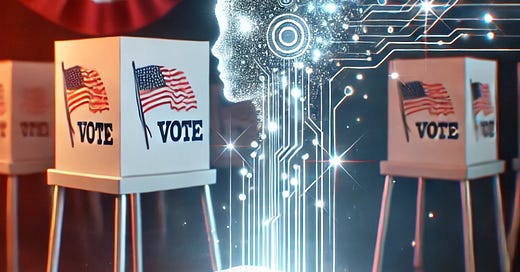Part III: The Abundance Institute AI and Elections Update
Tracking the Impact of AI on the 2024 Elections
Welcome to the third in our four-part series on AI and the 2024 election. Part I was published on May 9, 2024, 180 days out from the November election. Part II was published on August 7th, 2024, 90 days out from the November election. We will publish the fourth and last pre-election update 30 days out from the November 5, 2024, general election.
The U.S. votes in the 2024 presidential election in 60 days. This will be the first U.S. presidential election since the popularization of generative AI, which gives unprecedented access to tools capable of creating realistic, high-quality audio, visuals, and text. As noted in the introduction of Part I, the launch of ChatGPT in November 2022 sparked a wave of concerned statements from technologists, policymakers, and cultural commentators.
The most notable development since our previous update has been the release and integration of Grok-2 on the X platform. Grok-2 has taken a more laissez-faire approach to content generation policies of their chatbot. The effects of this approach have played out over the month of August.
This update covers instances of AI-generated content between August 8 and September 6, 2024.
Methodology
Our methodology has changed only slightly from that described in Part II. No substantive changes have been made to how we gather and track instances of AI election material. We once again upgraded public access to our dataset to a more user-friendly and attractive format at our website, the AI Election Observatory.
Identified Incidents in This Period
Image of Kamala Harris Rally in Detroit
On August 11, 2024, former President Donald Trump alleged on Truth Social that Vice President Kamala Harris used artificial intelligence to fabricate a crowd photo during an August 7 rally at an airport in Detroit. Trump’s post stated, “[h]as anyone noticed that Kamala CHEATED at the airport? There was nobody at the plane, and she ‘A.I.’d’ it, and showed a massive ‘crowd’ of so-called followers, BUT THEY DIDN’T EXIST!”
Trump’s post included a screenshot of an X post by social media strategist Chuck Callesto, which received 14.8 million views. Callesto’s post featured two images. The first image showed a large crowd at the rally, while the second, zoomed-in version, suggested the absence of a crowd reflection on the airplane. The BBC later reported that images from another angle indicated that the lack of reflection could be attributed to the specific area of empty tarmac.
Further analysis revealed that the contrast in the image shared by Trump appeared to have been digitally altered. Photographer Patrick Witty, in an X thread, pointed out minimal differences between the original image and the one that went viral, including a slightly warmer contrast, increased clarity, and cropping of the hangar at the top of the image.
Additional confusion arose from claims regarding the absence of visible tail numbers on Air Force Two. The United States Air Force clarified that this is a standard operational security measure.
Snopes, a fact-checking site, conducted several tests on the image. A reverse-image search yielded limited evidence. Two AI-detection tools, Winston AI Image Detector and isitai.com, were used to analyze the image. Winston AI concluded that the image was 96% likely to have not been AI-generated, while isit.ai indicated a 58% likelihood that the image was not AI-generated. The results underscore the limitations of AI detection tools, as discussed in previous reports by researchers.1
Subsequent reporting by The New York Times, AP News, and CBS News confirmed that the image was authentic and not AI-generated. The New York Times provided multiple images from different angles, showing a significant crowd. Although the image originally posted by Chuck Callesto and reposted by Donald Trump appeared to have minor visual alterations, such as cropping and brightness adjustments, the crowd was not created using generative AI.
Grok-2 Images Go Viral
On August 14, 2024, xAI (Elon Musk’s AI company) released the beta version of Grok-2 and Grok-2 Mini, their next-generation language models. According to an LLM testing benchmark, Grok-2 performs similarly to the best models created by OpenAI, Google, Anthropic, and Meta. Although similar in capability, Grok-2 stands out because of its less-restrictive content generation policies. Grok-2 allows users to generate images of celebrities or political figures even if the image is sensitive or controversial. For example, a recent image went viral of Presidential candidates Trump and Harris inhabiting the cockpit of a plane flying toward the World Trade Center, seemingly recreating events from 9/11. Other generated images include former presidents doing illicit drugs, Harris and Trump on a beach in bathing suits, and countless others. Grok-2 uses an open-source image generation model called Flux-1, which Musk has explained is an interim solution while xAI develops an in-house image generation model.
On September 1, 2024, Kamala Harris’ X account posted an image of Donald Trump overlayed with the text, “Donald Trump vows to be a dictator on day one.” The image does not appear to have been created with generative AI. In response to this post, Elon Musk posted an image of Kamala Harris wearing Soviet Union attire. The caption of Musk’s post read, “Kamala vows to be a communist dictator on day one. Can you believe she wears that outfit!?” Musk’s image appears to have been created with generative AI.
The response to Grok-2’s beta release and integration into X has been fierce. A letter initiated by Congresswoman Shontel Brown and signed by six other members of Congress2 was sent to the Federal Election Commission (FEC). The letter cites Grok-2’s release as the reason for supporting a petition by Public Citizen to prohibit deep fakes of an election candidate as fraudulent misrepresentation.
Another letter was sent by Minnesota Secretary of State Steve Simon to Elon Musk at X on August 5th, 2024 highlighting false election information generated by Grok and urging the company to change their policies.3 The letter highlighted an instance where Grok began generating text stating that ballots were closed in ten states.4 These ballots are not closed and the secretaries of state asserted that this information was not corrected until July 31st, 2024. They ended the letter by urging X to redirect Grok users to CanIVote.org, a policy that OpenAI has adopted with ChatGPT.
The Grok team has made changes with the release of Grok-2. Now when users prompt the chatbot with election-related questions, a banner is displayed at the top of the response stating, “[f]or accurate and up-to-date information about the 2024 U.S. Elections, please visit Vote.gov.”
Taylor Swift and other AI Images Posted by Trump
According to reporting by The Guardian, presidential candidate Donald Trump posted a collage on Truth Social of various images showing Taylor Swift fans endorsing his candidacy. The collage was posted on August 18, 2024, and mixes seemingly real images with generative AI images. Among the generative AI images is an image of Taylor Swift mimicking the personification of Uncle Sam with the tagline, “Taylor wants you to vote for Donald Trump.” On the same day Trump posted an AI-generated image on X showing Kamala Harris holding a militaristic Communist rally at the Democratic National Convention. This image was viewed 81 million times by X users.
Foreign Malign Influence Operations in 2024 U.S. Election Pivoting Away from AI
According to Microsoft’s August 8th Threat Intelligence Report, foreign bad actors are increasing activity in the U.S. 2024 election, but generative AI has had “limited to no impact.” The report focuses on Russia, China, and recently increased Iranian activities. While Kremlin efforts tend to focus on swaying voters, Iranian operations are more focused on disrupting election conduct and undermining trust in U.S. institutions. The report explains that while “nearly all actors seek to incorporate AI content in their operations … many actors have pivoted back to techniques that have proven effective in the past” such as “simple digital manipulations, mischaracterization of content, and use of trusted labels or logos atop false information.”
Conclusion
As the 2024 U.S. presidential election approaches, the intersection of generative AI and political content continues to earn significant media attention. The release of Grok-2 and its integration into X has sparked new coverage about AI-generated misinformation. However, the most malicious actors continue to focus on traditional manipulation techniques, such as content misrepresentation and digital editing. As a result, despite the growing availability of generative AI, its impact on voter behavior remains minimal.
Invitation to Collaborate
If there are any stories we missed or you would like to help our efforts, please fill out this Google Form. If there are search terms we should consider including please let us know. As the November election approaches in the U.S. we would especially appreciate your help in sending us examples of AI use in election material and examples of media stories that cover AI in elections. Our updates and tracking are primarily focused on U.S. elections although international stories are helpful for context. We welcome your help!
See Decoding Deepfakes: The Role of Zero-Knowledge Proofs in AI Verification by Logan Whitehair, and A Comprehensive Review of DeepFake Detection Using Advanced Machine Learning and Fusion Models by Gupta, et al.
The list of signees include: Congresswoman Eleanor Holmes Norton, Congresswoman Nikema Williams, Congressman Dan Goldman, Congressman Greg Landsman, Congresswoman Summer L. Lee, and Congressman Seth Magaziner.
The letter was signed by Steve Simon of Minnesota, Al Schmidt of Pennsylvania, Jocelyn Benson of Michigan, Steve Hobbs of Washington, and Maggie Toulouse Oliver of New Mexico.
The states that Grok made false assertions about include Alabama, Indiana, Michigan, Minnesota, New Mexico, Ohio, Pennsylvania, Texas, and Washington.







